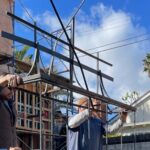The California Energy Commission has ruled that by 2020 solar panels will be required on all new homes with limited exemptions. For many people this may seem sudden. You may be one of them… feeling surprised, wanting to know more. However, this is one of several actions that have happened in the state over the last decade to move us toward sustainability–all as part of a larger plan.
It had already been mandated that, also by 2020, all new homes would be required to be net zero energy buildings (also known as net zero homes) in California. This means that there must be a zero net sum energy usage for the home–the home must not use more energy than it ‘makes’ and thereby not have a negative effect on the environment. Solar panels will be an important part of making this happen and can easily be incorporated into the design process for your new home. To help our clients understand these requirements, we are answering several frequently asked questions:
What will solar panels mean for my new house project?
With solar panels you will enjoy energy savings from day one on your electric bills. While there are additional upfront costs, it ends up saving money over time. There are also rebates at the state level that are available, which helps with those costs. As an added bonus, if you exceed your own use of electricity, you can sell it and see an immediate return on your investment.
For optimal operation it is important to think about where the panels will be positioned on the house. This, in turn, leads to consideration of how the house will be oriented on the property; specifically, the orientation of the roofs. If there are natural or manmade features adjacent that would shade the panels, this has to be allowed for. A good architect will do solar and shade studies to ensure proper orientation.
For homes built prior to 2020, space for solar panels is supposed to be allocated, though the homeowner need not install them. By leaving space for the panels, this will then allow future owners to add panels.
Solar panels are fairly lightweight. No special engineering is needed to the roofing system to support their installation. The weight of the panels is only a consideration if you plan to have a heavy roofing system such as clay tile, in which case additional support structures would be required anyway. However, it’s important to think through and plan the equipment, the meters and the routing back to the facility. There are also considerations of how the panels will be attached to the roof; it’s still necessary to penetrate the roof membrane all the while making sure to not create a leaking roof.
What if my property is completely shaded?
Even though the new mandate is for all new residential buildings of three stories or below, there are going to be situations where a property is mostly or entirely shaded. There are exemptions built into the law if it’s not feasible because the property is shaded by buildings or trees, for example.
Will solar panels ruin the look of my house?
There are many ways to hide the solar panels on a new home, partly or completely. This is easier to do on an slopped roof than on flat roofs. For example, you might have a parapet or other low level wall or barrier to hide the grid. The panels can also part of the design, aesthetically integrated so they are horizontal and flush. Think about how this is done with chimneys, flues, and vents.
An easy solution on a recent installation was to have the array on the south-facing roof, which was on the side of the building so it was not that prominent. We have two more projects at this time, and one of them is a flat array with a parapet. Because the house can be seen from a bluff above, we made a beautiful pattern with the array.






